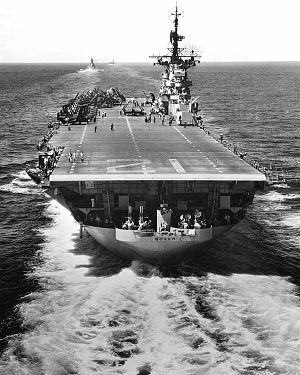U.S.S. Boxer (CV-21)

CV-21 General Specifications
Class: Essex-class aircraft carrier
Named for: HMS Boxer (1812)
Complement: 3448 Officers and Enlisted
Length: 888 feet
Draft: 28 feet 7 inches
Flank Speed: 33 knots
USS Boxer, a 27,100-ton Ticonderoga class aircraft carrier, was built at Newport News, Virginia. Commissioned in April 1945, she did not complete initial training in time to participate in World War II operations, but was actively employed in the Pacific during the Post-War years, making ten deployments to the Western Pacific from September 1945 into 1957. Boxer had just returned to the U.S. from her third deployment when the Korean War broke out in late June 1950. She carried badly-needed Air Force and Navy planes and personnel to the war zone in a record Pacific transit during July, then was quickly outfitted for combat service and spent September and October 1950 providing air support for United Nations' forces fighting ashore.
Boxer made three more Korean War cruises, in March-October 1951, March-September 1952 and May-November 1953. Her planes, along with those from other Task Force 77 carriers, hit transportation and infrastructure targets in North Korea and gave close air support to troops fighting on the front lines. On 5 August 1952, while engaged in combat operations, she suffered damage and casualties when a fire broke out in her hangar deck, but was able to return to duty off Korea after two weeks of repairs. Following her last Korean War deployment, which extended into the post-Armistice period, Boxer served as a Seventh Fleet attack carrier (CVA) on two more cruises, in 1954 and in 1955-56. Converted to an anti-submarine warfare aircraft carrier (CVS) in early 1956, she made a final Western Pacific tour in that role during 1956-57.
Later in 1957, Boxer operated briefly as an experimental assault helicopter aircraft carrier, an indication of things to come for her, the Navy and the Marine Corps. In 1958, she was flagship for Operation "Hardtack", a nuclear weapons test program in the Central Pacific. Late in that year, she was transferred to the Atlantic Fleet as an "interim amphibious assault ship"and was formally redesignated LPH-4 on 30 January 1959.
For the next decade, Boxer and her "main battery"of Marines and transport helicopters were vital components of the United States' amphibious warfare capabilities. She mainly operated in the Caribbean area, including participation in the 1962 Cuban Missile Crisis and the 1965 Dominican Republic intervention. She deployed to European waters in late 1964 to participate in Operation "Steel Pike". In mid-1965, Boxer served as an aircraft transport, carrying more than two-hundred Army helicopters and airplanes to Vietnam as part of the deployment of the First Cavalry Division (Air Mobile). After serving as a spacecraft recovery vessel in early 1966, she made a second trip to Vietnam, this time carrying Marine Corps aircraft. Boxer decommissioned in December 1969 and was sold for scrapping in February 1971.